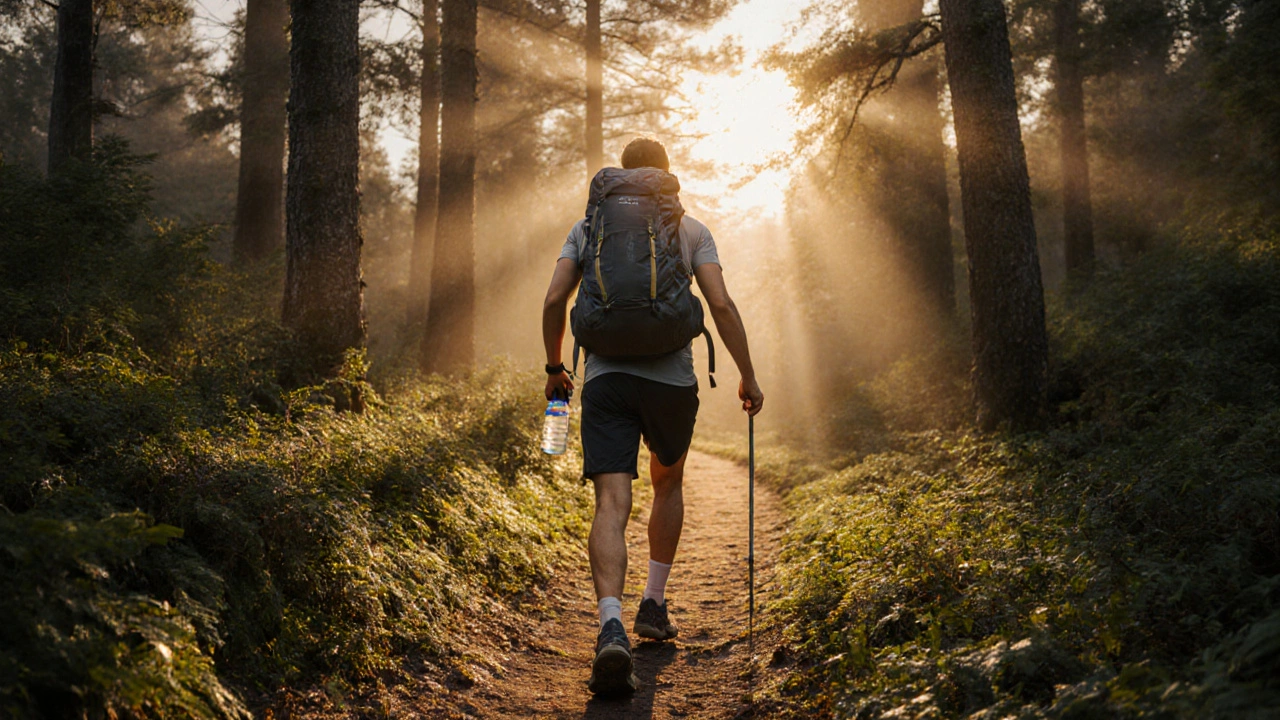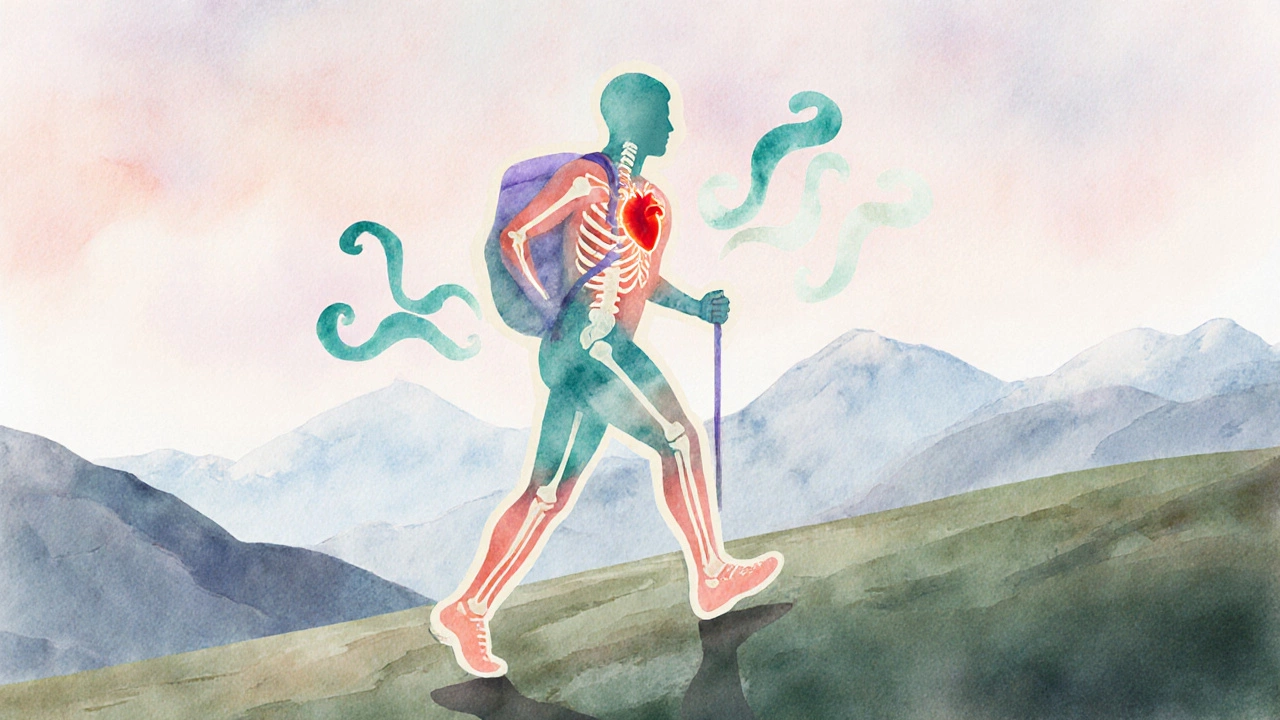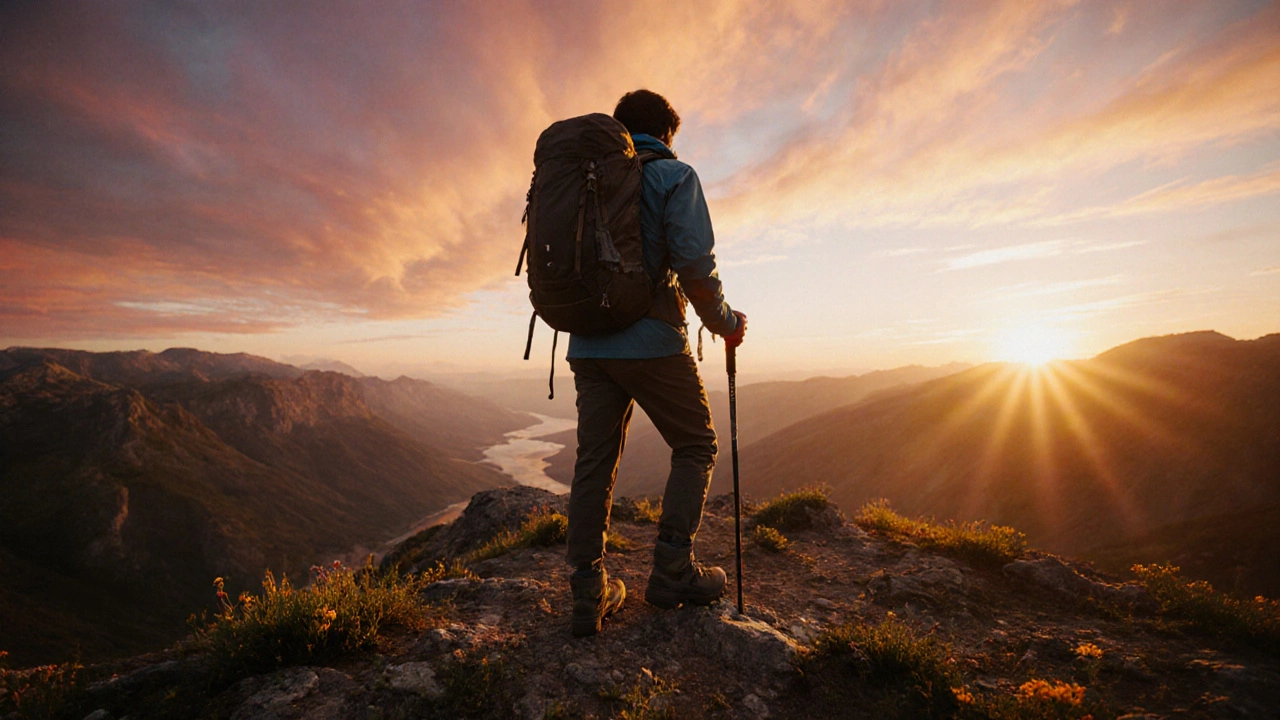Trekking for Health: Benefits, Risks & Getting Started

Trekking Calorie Calculator
How Many Calories Do You Burn?
Calculate your calorie burn based on trekking activity. This tool uses data from the American Heart Association and other studies.
Your calorie burn estimate will appear here
Trekking has become a go‑to activity for anyone looking to mix adventure with a solid workout. But does it really boost your health, or is it just a trendy way to burn calories? Below we break down the science, the perks, the pitfalls, and how to start safely.
Key Takeaways
- Trekking improves heart health, muscle tone, bone strength, and mental well‑being.
- Regular hikes (3‑5times a week, 60‑90minutes) can slash cardiovascular risk by up to 30%.
- Start slow, pick terrain that matches your fitness, and invest in supportive footwear.
- Watch for joint strain and altitude‑related issues; proper preparation cuts them down.
- Combine trekking with strength work for balanced fitness and injury prevention.
How Trekking Benefits the Cardiovascular System
When you hike uphill, your heart works harder to pump blood to the muscles. This steady aerobic challenge strengthens the Cardiovascular system is the network of heart, blood vessels, and blood that delivers oxygen and nutrients to body tissues. Studies from the American Heart Association show that moderate‑intensity trekking for 150minutes a week reduces LDL cholesterol by 10% and raises HDL by 8%.
Muscles and Bones: What Trekking Builds
Unlike flat‑ground running, trekking involves uneven surfaces and elevation changes, forcing the Musculoskeletal system is the combination of muscles, bones, tendons, and ligaments that supports movement and posture to adapt. Quad, glute, and calf muscles get a solid workout, while the impact stimulates Bone density is the amount of mineral matter per cubic centimeter of bones, indicating strength and health. A 2023 meta‑analysis found a 2‑3% increase in femoral bone density after six months of weekly hikes for adults over 50.
Mental Health Boosts from the Trail
Being outdoors triggers the release of serotonin and endorphins. The Mental health is a state of emotional and psychological well‑being that enables individuals to cope with stress, relate to others, and make choices benefits are measurable: hikers report 30% lower scores on the Perceived Stress Scale after a single 3‑hour trek. The combination of rhythmic movement, fresh air, and natural scenery also improves attention span, a phenomenon known as “attention restoration.”

Weight Management and Calorie Burn
Because trekking engages large muscle groups and often lasts longer than a gym cardio session, it can torch 400‑800calories per hour depending on terrain and speed. The Calorie burn is the amount of energy expended during physical activity, measured in kilocalories (kcal) translates into steady weight loss when paired with a balanced diet. A real‑world example: a 70‑kg person walking 10km on moderate hills for 2hours burned roughly 950kcal, equivalent to a brisk 45‑minute run.
Immune System Perks
Regular exposure to varied microbes in nature can strengthen the Immune system is the body’s defense network of cells, tissues, and organs that fight infections and diseases. A 2022 trial in Finland showed that participants who hiked at least three times a week had 20% fewer upper‑respiratory infections over the winter compared to sedentary controls.
Altitude Adaptation: A Double‑Edged Sword
Higher elevations mean thinner air, prompting the body to produce more red blood cells-a process called Altitude adaptation is physiological adjustments such as increased erythropoietin production that improve oxygen delivery at low atmospheric pressure. While beneficial for endurance athletes, rapid ascents can cause acute mountain sickness. Gradual climbs (no more than 300m gain per day) and staying hydrated mitigate these risks.
Getting Started: Gear, Safety, and a Simple Plan
If you’re new to trekking, start with low‑impact trails (2‑4km, gentle elevation). The most crucial gear is a pair of sturdy, well‑fitted hiking boots-look for ankle support and breathable waterproof membranes. Add a lightweight backpack, a reusable water bottle, and a basic first‑aid kit.
- Assess your fitness. Perform a 30‑minute brisk walk; if you can finish without gasping, you’re ready.
- Choose terrain. Flat park loops are ideal for the first week; progress to rolling hills in week two.
- Set a schedule. Aim for three sessions per week, each 60‑90minutes, with a rest day in between.
- Track progress. Use a simple app to log distance, elevation, and how you felt; adjust intensity based on trends.
- Warm‑up and cool‑down. 5‑minute dynamic stretches before, static stretches after to protect joints.
Listen to your body-sharp knee pain or persistent shortness of breath warrants a pause and possibly a check‑up.

How Trekking Stacks Up Against Walking and Running
| Metric | Trekking | Walking (brisk) | Running (10km/h) |
|---|---|---|---|
| Average kcal/hr | 600‑800 | 300‑400 | 650‑900 |
| Joint impact (scale 1‑5) | 2‑3 (surface dependent) | 1 (low) | 4 (high) |
| Muscle groups engaged | Legs, core, stabilizers | Legs, hips | Legs, core |
| Outdoor exposure | High (often remote) | Medium (parks, streets) | Medium‑High (depends on route) |
| Bone density benefit | Strong | Moderate | Moderate‑High |
In short, trekking offers a middle ground: higher calorie burn than walking, lower joint stress than running, plus the added mental boost of nature.
Common Pitfalls and How to Avoid Them
- Skipping warm‑ups. Leads to muscle strains-do 5‑minute leg swings and ankle circles.
- Over‑packing. Heavy backpacks turn a pleasant hike into a joint‑killer; keep load under 10% of body weight.
- Neglecting hydration. Even mild altitude can cause dehydration; aim for 2‑3L of fluid per day.
- Ignoring weather. Sudden storms increase slip risk-check forecasts and carry a lightweight rain shell.
Wrap‑Up: Is Trekking Worth It for Your Health?
All signs point to a resounding yes. The blend of cardiovascular conditioning, muscle strengthening, bone health, and mental clarity makes trekking a holistic fitness choice. Start easy, stay consistent, and watch the benefits pile up-one step at a time.
Frequently Asked Questions
How often should I trek to see health improvements?
Aim for three sessions per week, each lasting 60‑90minutes. Consistency over intensity yields the best cardiovascular and mental gains.
Can trekking help with weight loss?
Yes. Burning 500‑800calories per hike, combined with a balanced diet, can create a weekly deficit of 1500‑2400kcal, translating to roughly 0.5kg of weight loss per week.
Is trekking safe for people with joint problems?
Choose low‑impact trails, use supportive shoes, and keep the backpack light. If pain persists, consult a physiotherapist before continuing.
Do I need special equipment for high‑altitude trekking?
Beyond a good pair of boots, pack layers, a headlamp, and a hydration system. For altitudes above 3000m, consider a portable oxygen monitor and acclimatization days.
How does trekking compare to gym cardio for heart health?
Both improve VO₂ max, but trekking adds uneven terrain, which forces the heart to adapt to variable loads, often resulting in a slightly higher long‑term benefit for blood pressure regulation.
